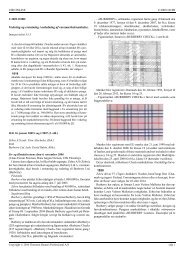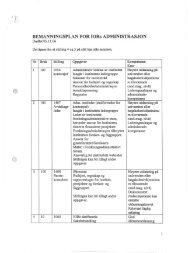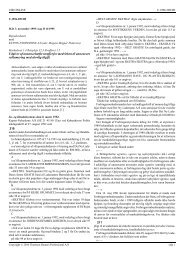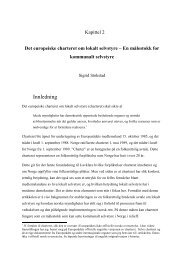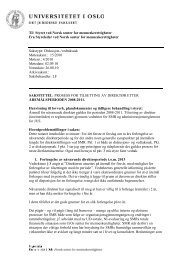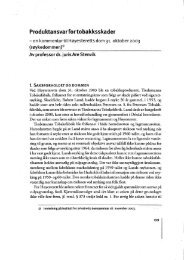Lee A. Bygrave (red.) YULEX 2002 - Universitetet i Oslo
Lee A. Bygrave (red.) YULEX 2002 - Universitetet i Oslo
Lee A. Bygrave (red.) YULEX 2002 - Universitetet i Oslo
You also want an ePaper? Increase the reach of your titles
YUMPU automatically turns print PDFs into web optimized ePapers that Google loves.
............................................................................<br />
94 Stephen K Karanja<br />
Central SIS (CSIS), situated in Strasbourg, France (Schengen Convention,<br />
Article 92). The NSIS enables designated national authorities to carry out<br />
searches in SIS. The CSIS ensures that data files of the national sections are<br />
updated and kept identical at all times by online transmission of information.<br />
The SIS is the most important technological compensatory measure in the<br />
removal of internal borders in the Schengen co-operation. It is a fundamental<br />
requirement for implementation of the Schengen Convention. No country<br />
may commence implementation of the Convention before SIS has been established.<br />
The persons I interviewed at the Ministry of the Interior were of the<br />
opinion that SIS plays an important role in crime and border control. 5 Hence,<br />
it has become a very important tool in day-to-day police work. To illustrate<br />
this, one interviewee refer<strong>red</strong> to the first case to be solved through SIS in<br />
Norway. 6 He emphasised that, had it not been for the Schengen co-operation<br />
and SIS, such a quick arrest could not have been possible. My experience in<br />
crossing the Schengen external border between Austria and her two non-<br />
Schengen neighbours – Hungary and Slovakia – confirms that SIS has indeed<br />
become an important tool in border control work. 7<br />
3.2 Establishment of the System and Data Modelling<br />
As the responsibility for establishing the national part of SIS – NSIS – is left<br />
to individual Contracting Parties (Article 92), countries have come up with<br />
different technical and data-modelling solutions. The question regarding the<br />
establishment and data modelling was aimed at finding the path the Austrian<br />
authorities had followed and whether it had been influenced by other Contracting<br />
Parties’ solutions.<br />
The findings reveal that, in Austria, the Ministry of the Interior has responsibility<br />
for the operation of SIS and, therefore, undertook the task of<br />
establishing the system. However, the establishment efforts involved other<br />
government ministries, namely the Ministry of International Affairs, the Min-<br />
5<br />
See section 5 – The Role of SIS in Interstate Co-operation.<br />
6<br />
The case was reported in VG and Dagsavisen on 26 January 2001. It involved the arrest of<br />
an Iranian man who had been charged in a German court for organised human smuggling.<br />
As a result of a search in SIS, he was arrested in Bergen, Norway, where he had sought asylum.<br />
He had been registe<strong>red</strong>, under many aliases, as a wanted person by a court in Leipzig<br />
in the former East Germany. One of the names was identical to the name he used in Norway.<br />
According to Dagsavisen, if it were not for SIS, the man would have lived unnoticed<br />
in Norway. The person had resided for many months in Bergen and had established himself<br />
with his own apartment.<br />
7<br />
See my article, “Crossing the Schengen External Border”, in LA <strong>Bygrave</strong> (ed), Yulex 2001<br />
(<strong>Oslo</strong>: Institutt for rettsinformatikk, 2001), pp 93–102.







